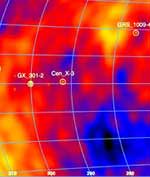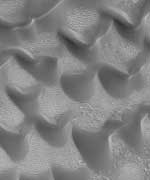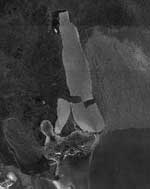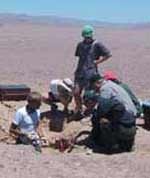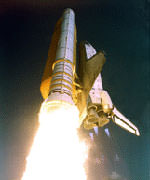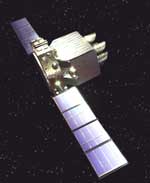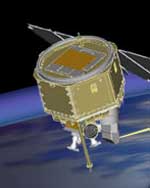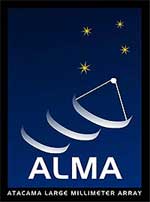
Image credit: ESO
Workers in Chile broke ground today in the construction of the Atacama Large Millimeter Array (ALMA) – a giant radio telescope made up of 64 high-precision radio antennas. ALMA is scheduled to be completed in 2012, but radio astronomers will be able to start using it in 2007, when some of the antennas have been completed. Using interferometry, the radio signals from the individual 12-metre dishes will be combined to act like a single radio telescope 14 kilometres across. Needless to say, it will help astronomers push much deeper into the cosmos when viewing the radio spectrum.
Scientists and dignitaries from Europe, North America and Chile are breaking ground today (Thursday, November 6, 2003) on what will be the world’s largest, most sensitive radio telescope operating at millimeter wavelengths.
ALMA – the “Atacama Large Millimeter Array” – will be a single instrument composed of 64 high-precision antennas located in the II Region of Chile, in the District of San Pedro de Atacama, at the Chajnantor altiplano, 5,000 metres above sea level. ALMA’s primary function will be to observe and image with unprecedented clarity the enigmatic cold regions of the Universe, which are optically dark, yet shine brightly in the millimetre portion of the electromagnetic spectrum.
The Atacama Large Millimeter Array (ALMA) is an international astronomy facility. ALMA is an equal partnership between Europe and North America, in cooperation with the Republic of Chile, and is funded in North America by the U.S. National Science Foundation (NSF) in cooperation with the National Research Council of Canada (NRC), and in Europe by the European Southern Observatory (ESO) and Spain. ALMA construction and operations are led on behalf of North America by the National Radio Astronomy Observatory (NRAO), which is managed by Associated Universities, Inc. (AUI), and on behalf of Europe by ESO.
“ALMA will be a giant leap forward for our studies of this relatively little explored spectral window towards the Universe”, said Dr. Catherine Cesarsky, Director General of ESO. “With ESO leading the European part of this ambitious and forward-looking project, the impact of ALMA will be felt in wide circles on our continent. Together with our partners in North America and Chile, we are all looking forward to the truly outstanding opportunities that will be offered by ALMA, also to young scientists and engineers”.
“The U.S. National Science Foundation joins today with our North American partner, Canada, and with the European Southern Observatory, Spain, and Chile to prepare for a spectacular new instrument,” stated Dr. Rita Colwell, director of the U.S. National Science Foundation. “ALMA will expand our vision of the Universe with “eyes” that pierce the shrouded mantles of space through which light cannot penetrate.”
On the occasion of this groundbreaking, the ALMA logo was unveiled.
Science with ALMA
ALMA will capture millimetre and sub-millimetre radiation from space and produce images and spectra of celestial objects as they appear at these wavelengths. This particular portion of the electromagnetic spectrum, which is less energetic than visible and infrared light, yet more energetic than most radio waves, holds the key to understanding a great variety of fundamental processes, e.g., planet and star formation and the formation and evolution of galaxies and galaxy clusters in the early Universe. The possibility to detect emission from organic and other molecules in space is of particularly high interest.
The millimetre and sub-millimetre radiation that ALMA will study is able to penetrate the vast clouds of dust and gas that populate interstellar (and intergalactic) space, revealing previously hidden details about astronomical objects. This radiation, however, is blocked by atmospheric moisture (water molecules) in the Earth’s atmosphere. To conduct research with ALMA in this critical portion of the spectrum, astronomers thus need an exceptional observation site that is very dry, and at a very high altitude where the atmosphere above is thinner. Extensive tests showed that the sky above the high-altitude Chajnantor plain in the Atacama Desert has the unsurpassed clarity and stability needed to perform efficient observations with ALMA.
ALMA operation
ALMA will be the highest-altitude, full-time ground-based observatory in the world, at some 250 metres higher than the peak of Mont Blanc, Europe’s tallest mountain.
Work at this altitude is difficult. To help ensure the safety of the scientists and engineers at ALMA, operations will be conducted from the Operations Support Facility (ALMA OSF), a compound located at a more comfortable altitude of 2,900 metres, between the cities of Toconao and San Pedro de Atacama.
Phase 1 of the ALMA Project, which included the design and development, was completed in 2002. The beginning of Phase 2 happened on February 25, 2003, when the European Southern Observatory (ESO) and the US National Science Foundation (NSF) signed a historic agreement to construct and operate ALMA, cf. ESO PR 04/03.
Construction will continue until 2012; however, initial scientific observations are planned already from 2007, with a partial array of the first antennas. ALMA’s operation will progressively increase until 2012 with the installation of the remaining antennas. The entire project will cost approximately 600 million Euros.
Earlier this year, the ALMA Board selected Professor Massimo Tarenghi, formerly manager of ESO’s VLT Project, to become ALMA Director. He is confident that he and his team will succeed: “We may have a lot of hard work in front of us”, he said, “but all of us in the team are excited about this unique project. We are ready to work for the international astronomical community and to provide them in due time with an outstanding instrument allowing trailblazing research projects in many different fields of modern astrophysics”.
How ALMA will work
ALMA will be composed of 64 high-precision antennas, each 12 metres in diameter. The ALMA antennas can be repositioned, allowing the telescope to function much like the zoom lens on a camera. At its largest, ALMA will be 14 kilometers across. This will allow the telescope to observe fine-scale details of astronomical objects. At its smallest configuration, approximately 150 meters across, ALMA will be able to study the large-scale structures of these same objects.
ALMA will function as an interferometer (according to the same basic principle as the VLT Interferometer (VLTI) at Paranal). This means that it will combine the signals from all its antennas (one pair of antennas at a time) to simulate a telescope the size of the distance between the antennas.
With 64 antennas, ALMA will generate 2016 individual antenna pairs (“baselines”) during the observations. To handle this enormous amount of data, ALMA will rely on a very powerful, specialized computer (a “correlator”), which will perform 16,000 million million (1.6 x 1016) operations per second.
Currently, two prototype ALMA antennas are undergoing rigorous testing at the NRAO’s Very Large Array site, near Socorro, New Mexico, USA.
International collaboration
For this ambitious project, ALMA has become a joint effort among many nations and scientific institutions. In Europe, ESO leads on behalf of its ten member countries (Belgium, Denmark, France, Germany, Italy, The Netherlands, Portugal, Sweden, Switzerland and the United Kingdom) and Spain. Japan may join in 2004, bringing enhancements to the project. Given the participation of North America, this will be the first truly global project of ground-based astronomy, an essential development in view of the increasing technological sophistication and the high costs of front-line astronomy installations.
The first submillimeter telescope in the southern hemisphere was the 15-m Swedish-ESO Submillimetre Telescope (SEST) which was installed at the ESO La Silla Observatory in 1987. It has since been used extensively by astronomers, mostly from ESO’s member states. SEST has now been decommissioned and a new submillimetre telescope, APEX, is about to commence operations at Chajnantor. APEX, which is a joint project between ESO, the Max Planck Institute for Radio Astronomy in Bonn (Germany), and the Onsala Space Observatory (Sweden), is an antenna comparable to the ALMA antennas.
Original Source: ESO News Release
